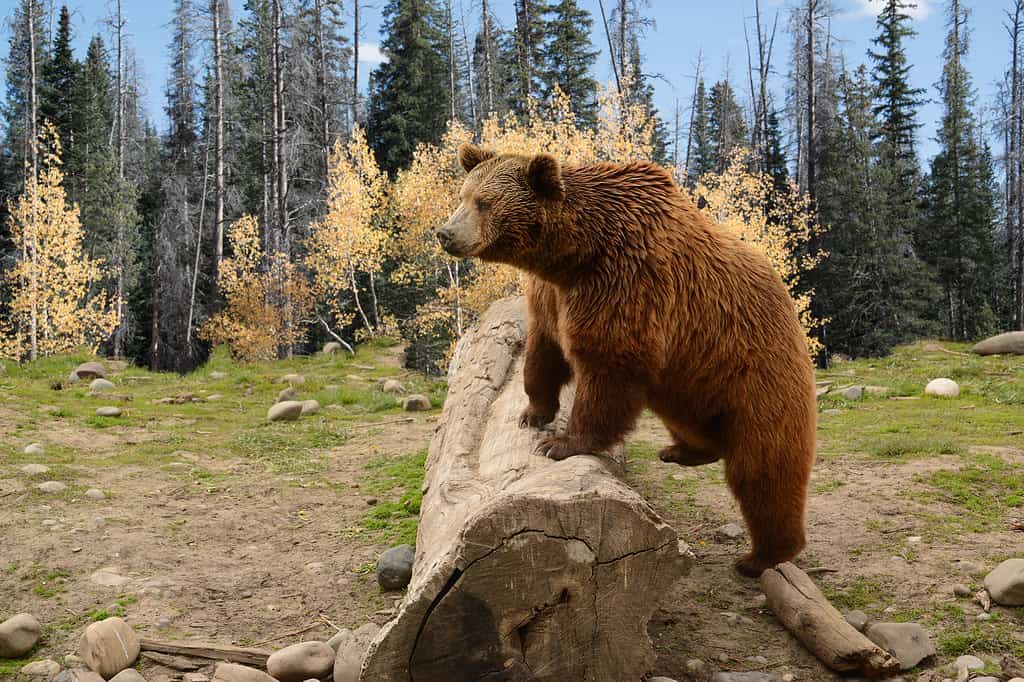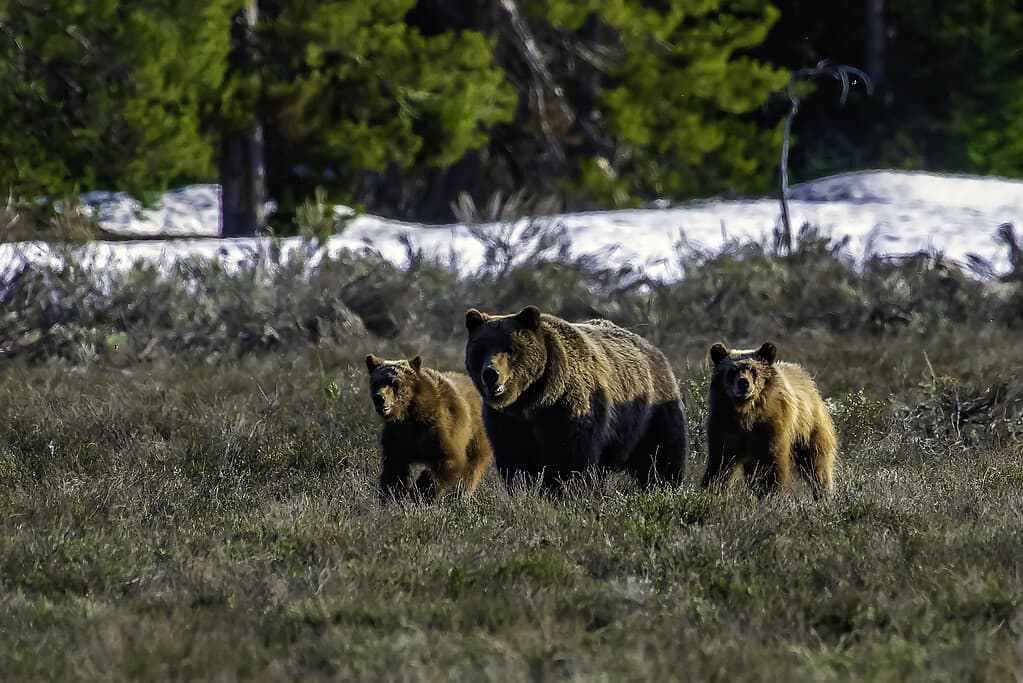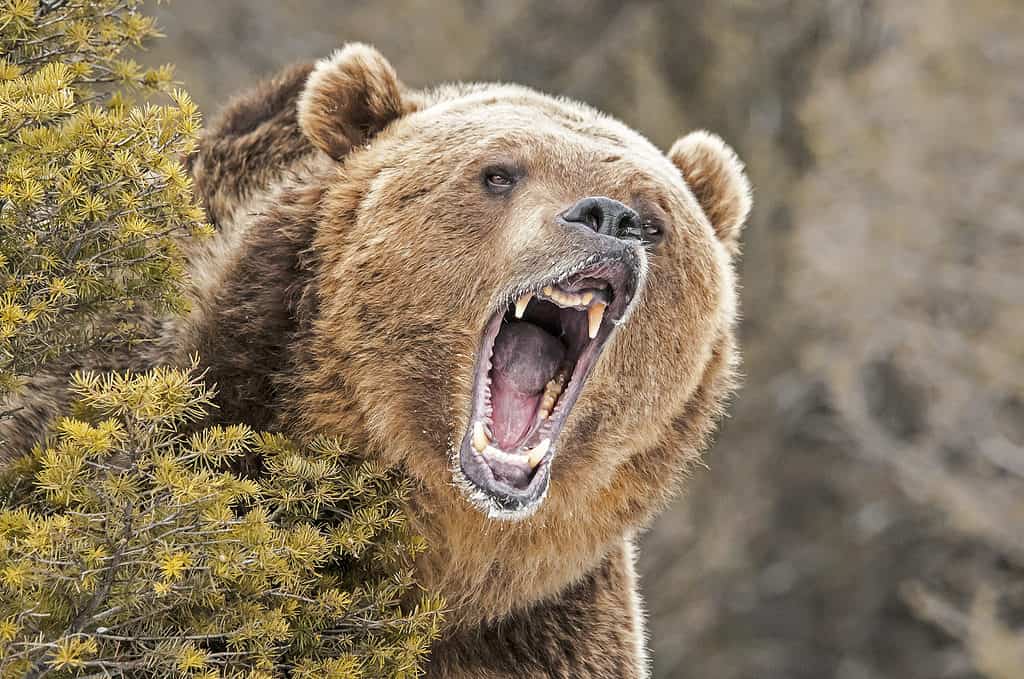Grizzly bears are some of the largest and most fearsome bears around. They are known for their bulky appearance and excellent hunting skills. However, although grizzly bears were once widespread across the United States, they are now restricted to only a few states, including Wyoming. So, keep reading to discover everything you need to know about grizzly bears in Wyoming, including where they live, what they eat, and how dangerous they are!
Where Do Grizzly Bears Live?

Grizzly bears live in a wide variety of habitats.
©Georgia Evans/iStock / Getty Images Plus via Getty Images
Grizzly bears (Ursus arctos horribilis) are a subspecies of the brown bear that inhabits North America. They are amongst some of the largest bears in the world. They are typically three to five feet high at the shoulder but can reach nine feet high when they are standing on their hind legs. Males are larger than females and weigh in at anything up to 600 pounds on average.
Grizzly bears inhabit only five states — Alaska, Idaho, Montana, Washington, and Wyoming. They live in a variety of habitats, including forests, grasslands, prairies, and alpine meadows. However, grizzly bears hibernate in dens, which are usually dug into slopes. The den is small to try and keep as much heat in as possible. Grizzly bears hibernate for five to seven months and usually emerge in March.
How Many Grizzly Bears Are There in Wyoming?

There is now a healthy population of grizzly bears in Wyoming.
©John Morrison/iStock / Getty Images Plus via Getty Images
There are currently around 600 grizzly bears in Wyoming, including approximately 250 in Yellowstone National Park. Their range is now gradually expanding from Yellowstone across the rest of the state.
Grizzly bears were once widespread across Wyoming, with a large population inhabiting the state. However, they almost became extinct in the state due to an extended period of hunting. As more settlers began to inhabit the state, they came into closer contact with the bears, resulting in conflict between the two. Grizzly bears were also widely considered to be a game species in the state and were regularly hunted until they were eventually made an endangered species in 1975.
Grizzly bears remain an endangered species as they are still threatened by habitat loss due to factors such as logging, mining, and development. However, they are also affected by an extremely low reproductive rate, which means that the population doesn’t recover quickly. Grizzly bears do not reach sexual maturity until they are four to nine years old. They also only have a small litter size (one to four cubs), and the cubs remain with their mother for up to three years. As a result, grizzly bears only give birth every two to three years.
What Do Grizzly Bears Eat?
Like all bears, grizzly bears are actually omnivores, meaning that they eat both meat and vegetation. When it comes to vegetation, grizzly bears have a varied diet. They eat a wide range of fruit, nuts, berries, roots, grasses, and even honey.
Grizzly bears are also skilled hunters, and they are capable of catching and killing a variety of animals. This includes fish, rodents, and even larger animals such as moose and elk. One of their greatest assets when hunting is their long, sharp claws which can inflict serious damage with just one swipe of their paw. However, they are also regarded as scavengers and are able to detect carrion from many miles away due to their excellent sense of smell.
Are Grizzly Bears Dangerous?

Grizzly bears can be dangerous if they are threatened or provoked.
©Scott E Read/Shutterstock.com
Grizzly bears are incredibly powerful animals and can be dangerous to humans. Despite their size, grizzly bears are incredibly agile and are quick runners, capable of attaining speeds of up to 35 miles per hour. This, combined with their sharp teeth, claws, and a bite force of 975 PSI, makes them a fierce predator.
Although they can be dangerous, grizzly bears do not typically attack humans unless they are threatened or provoked. However, females will attack if you get between her and her cubs or if she thinks that her cubs are threatened in some way.
If you do encounter a grizzly then the bear’s initial reaction will likely be to retreat, especially if it sees or hears you before you actually come upon it. If you do see a grizzly then you should try to stay calm and slowly back away without making any sudden movements. However, if the bear attempts to approach you, then the official state advice is to stand your ground and use bear spray if you have it. Never run away from a bear, as it will be more likely to give chase, and it is impossible to outrun a grizzly.
If you’re hiking or traveling, then you can minimize the risk of a bear encounter by staying in a group. Also, keeping the area clean and tidy can prevent bears from being attracted to food or trash.
The photo featured at the top of this post is © BlueBarronPhoto/Shutterstock.com
Thank you for reading! Have some feedback for us? Contact the AZ Animals editorial team.







